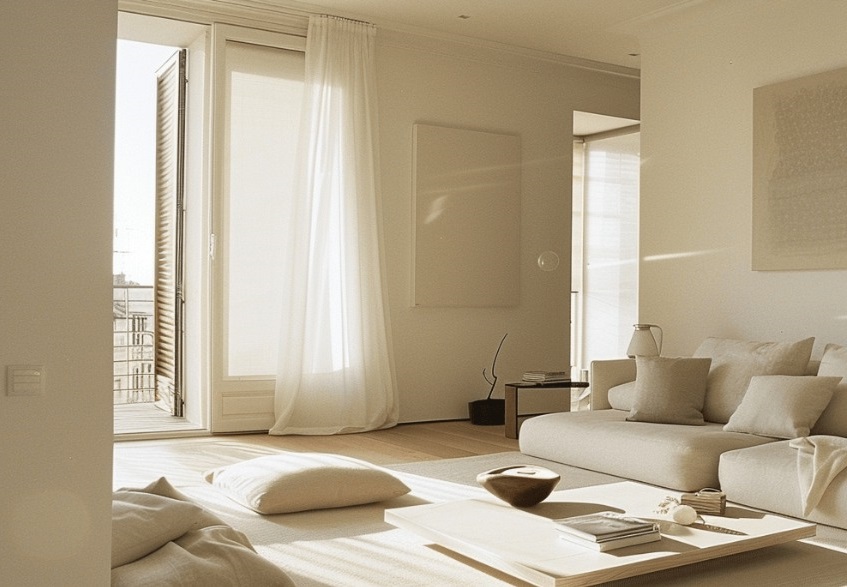Minimalism celebrates the art of stylish simplicity. Yet, a home designed with this principle does not feel empty and dull. On the contrary, the absence of excess creates a living space filled with light and tranquility, making it a soothing place to unwind.
We will provide you with all the necessary information about this style and offer furnishing ideas to achieve the aesthetic.
This is minimalism: defining the look and feel
Origins and Traits of the Minimalist Interior Design Trend
A minimalist style requires little to be content – a sofa, a simple glass table, and a sideboard. It prefers uncluttered floors and walls, few furniture pieces with clean lines, and eschews unnecessary home decorations. Intricate patterns and bold colors are absent; instead, understated tones like white, gray, or beige predominate.
The outcome is an airy, well-lit space that exudes a sense of openness. Within these walls, one’s mind finds serenity, as excess distractions are minimized. This philosophy was embraced by the proponents of the Minimal Art movement, which birthed this furniture style. This art form employed a straightforward formal language with distinct geometric shapes.
The art of reduction inspired many in the 1960s and swiftly extended to other domains. Thus, minimalism made its way into music and theater – and
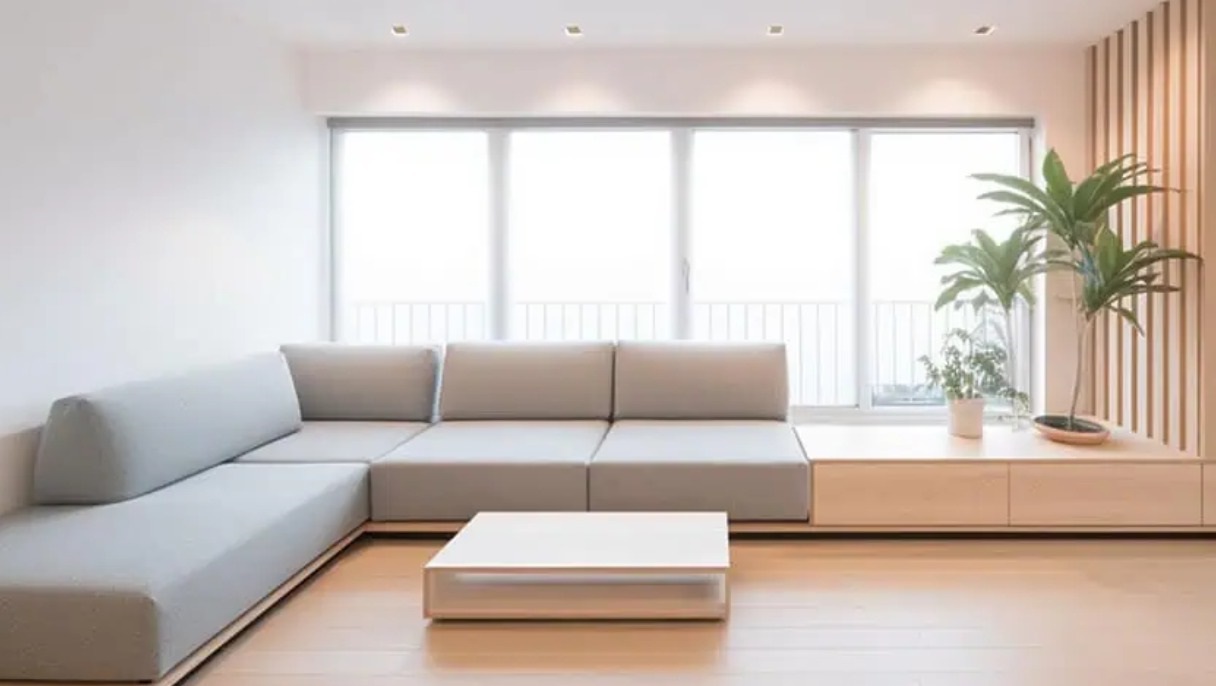
Minimalist living: The Benefits of a Simplified Furniture Style
Simplicity enhances living comfort
Researchers at Princeton University recently demonstrated that the brain favors minimal stimulation. A cluttered environment hinders productivity and induces persistent underlying stress. Streamlined furniture heightens your sense of well-being and comfort.
A prime example is a minimalist study. Here, the desk remains uncluttered and neat, without the distraction of vacation photos in Italy adorning the opposite wall. The result: a more relaxed work environment.
Simplicity also creates more space. In essence, space for grand ideas.
Minimalism saves money
Plain and pragmatic, minimalism saves you money. That vibrant runner you’ve been eyeing doesn’t complement your pristine bedroom. Let your beautiful parquet flooring shine. Your aesthetic sensibilities and your wallet will both rejoice.
Simplified living eases cleaning
Minimalist living simplifies your cleaning routine. There are no dust-collecting crystal figurines on the windowsill in this abode. The natural surroundings suffice as home décor for minimalists, and they’re much easier to maintain than any home accessory.
Minimalist living room: Interior Design Concepts
The living room is the heart of your home, blending personal space with a public area. After all, this is where you entertain guests. Consequently, a minimalist living room cleverly combines pure functionality with a hint of comfort. How is this achieved?
The foundation of a minimalist living room
To start, furniture with distinct lines establishes a serene foundation. This encompasses tall shelves, enclosed cabinets, simple sofas, and compact tables. Rather than color, these elements captivate with intriguing textures. Materials like wood, glass, or chrome are ideal for this purpose.
Carefully chosen accessories complete the room
To infuse a sense of warmth into this modest furniture collection, select accessories are added to create visual interest. A coffee table with a picture book beckons, while a throw on the sofa invites you to snuggle up. A framed photo of your favorite artist lends a personal touch, and a potted plant introduces life into the space.
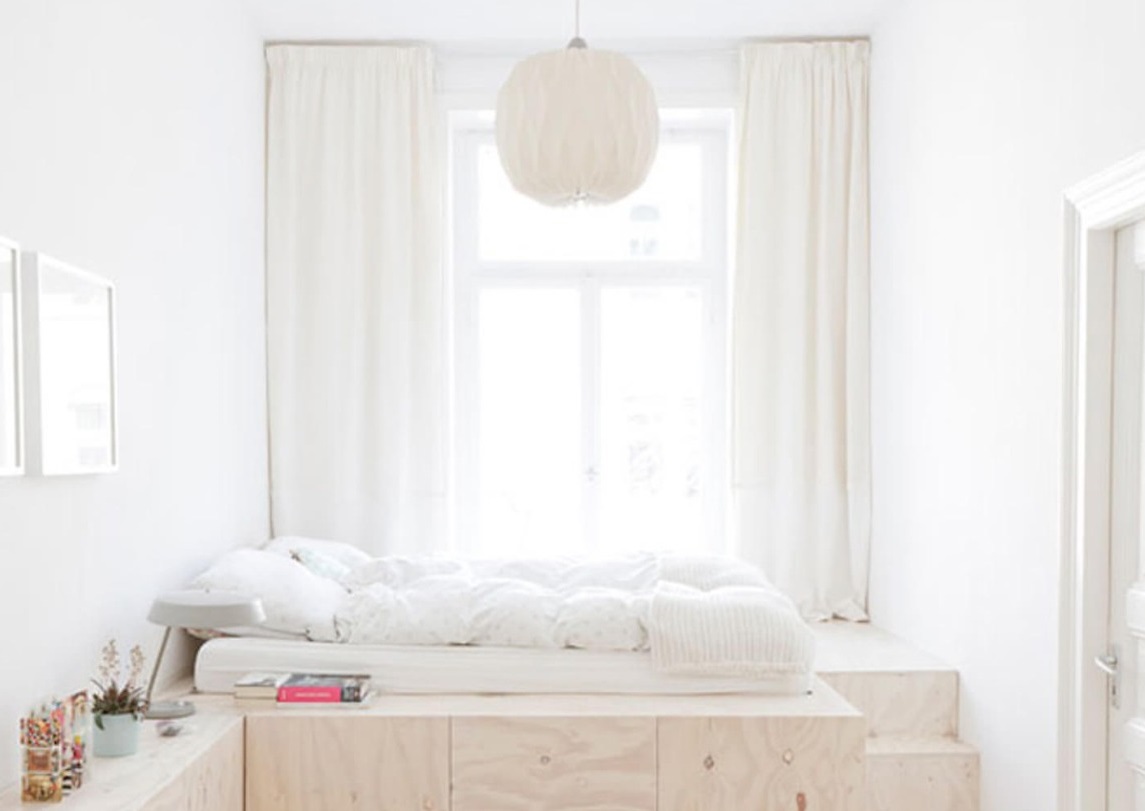
Minimalist children’s room: Fewer furnishings, Maximum enjoyment
Young ones often accumulate an abundance of possessions. How does the ethos of simplicity translate in this context? In a nutshell: by turning it into a game.
Ask your child to compile a list. Here, they note down the ten toys they truly need. The rest of their belongings are stored away. Anything untouched for three months is permanently removed. As a result, the colorful surplus gradually diminishes, while the play area expands.
By implementing these minimalist tips, the room becomes a minimalist children’s space with appropriate furniture. Soft, cozy vibes are created through a maximum of two pastel wall colors. Furniture matching the color scheme exhibits clean lines, and a simple white ceiling light casts a warm glow over everything.
Minimalism in the children’s room
More room for imagination
Inviting, subtle, and light – minimalism in the children’s room imparts a tidy and snug ambiance. This furniture style stimulates your child’s creativity and provides ample space for play. With the right furniture, a consistent color palette, and a few home accents, this trend will capture your little one’s fascination in no time. True to its ethos: Keep it simple!
Using Imagination for Maximum Fun in a Minimalist Children’s Room
What would you do if your child suddenly decided to clean up their own room? In a minimalist kids room, this could happen quickly. Minimalist living means having only what’s necessary – and not the bare minimum. This creates more space and gives the room a tidier and calmer appearance. You’re likely familiar with this feeling. When you’re surrounded by fewer distractions, you feel more balanced and relaxed, and the same applies to your little ones. Additionally, minimalist furniture promotes playfulness and creativity.
The Influence of Minimalism on Children’s Rooms
Think minimalist and kids’ rooms don’t go together? Think again! This trend not only looks stylish but also makes your child’s favorite space appear tidy and cozy. The key elements include:

Children’s Furniture: Consistency is Key
Clear lines and soft, bright colors bring visual tranquility to the room. When all the furniture pieces come from the same collection, they effortlessly blend together. Combining pastel and gray tones creates a soft and gentle look. These soft colors contrast with the colorful toys, which in themselves bring vibrancy into the kid’s room.
Organized Toy Storage
Everything in the box! In the evening, toys are sorted by theme or material and placed in large storage containers matching the wall color. Your toddler can join in on the fun, and tidying up becomes an enjoyable sorting game in no time.
Limit Wall Colors to Two Shades
For both minimalist living spaces and children’s rooms, the rule is less is more. Pastel colors like mint, blush pink, or soft yellow create a cheerful yet not overly colorful vibe. If the wall color matches the furniture, they seamlessly blend into the background. White is a great option, and light gray or beige are also trendy in children’s rooms. Currently popular graphic animal motifs on a white backdrop add a sweet touch, and when placed within white frames, they adorn empty walls.
Proper Lighting for Your Children
A simple designed white ceiling lamp complements a minimalist children’s room perfectly. Alternatively, you can opt for a cute and colorful version to provide a contrast.
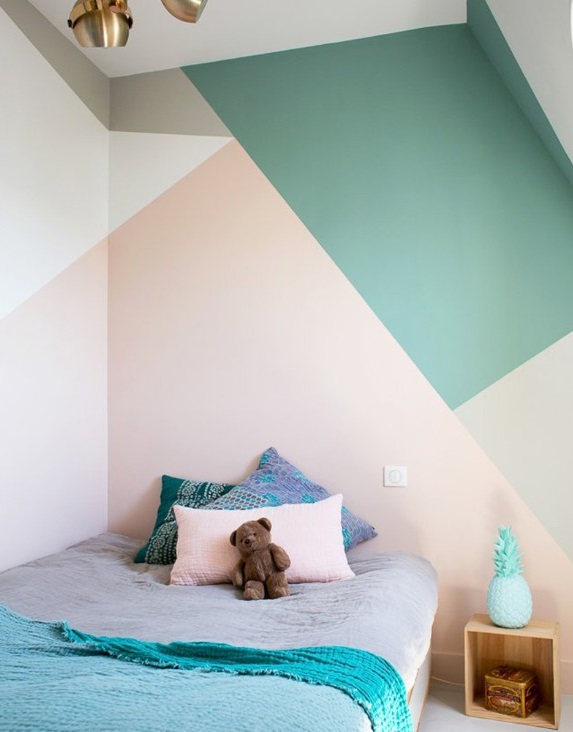
Where’s the Decor?
Minimalist style calls for minimal accessories. Stuffed animals, your child’s initial letter, and a cute nostalgic cardboard suitcase in the same color – nothing more. A few pillows and blankets in similar colors create coziness in the room.
Determining Essential Toys
“NOOOOO” is the typical response when you suggest moving one of their toys to the basement. Many children find it hard to let go of things. Here’s a trick to find out which toys your child can part with: Ask them to choose the ten items they want to keep. Store everything else on a shelf or board. If something has been there for three months without your child asking for it, it can be given away. Another fun idea is to visit a flea market together. Perhaps your child might want to sell something themselves.
An Overview of Key Minimalist Concepts
Styling a minimalist room is simple: combine light-colored furniture with matching pastel wall tones and a few decorative pieces. Keep walls and floors clear. If you find minimalism too strict, you might want to consider wabi sabi. Despite its name, it’s not sushi pasta but a trend currently popular in Japan, representing imperfect furniture.
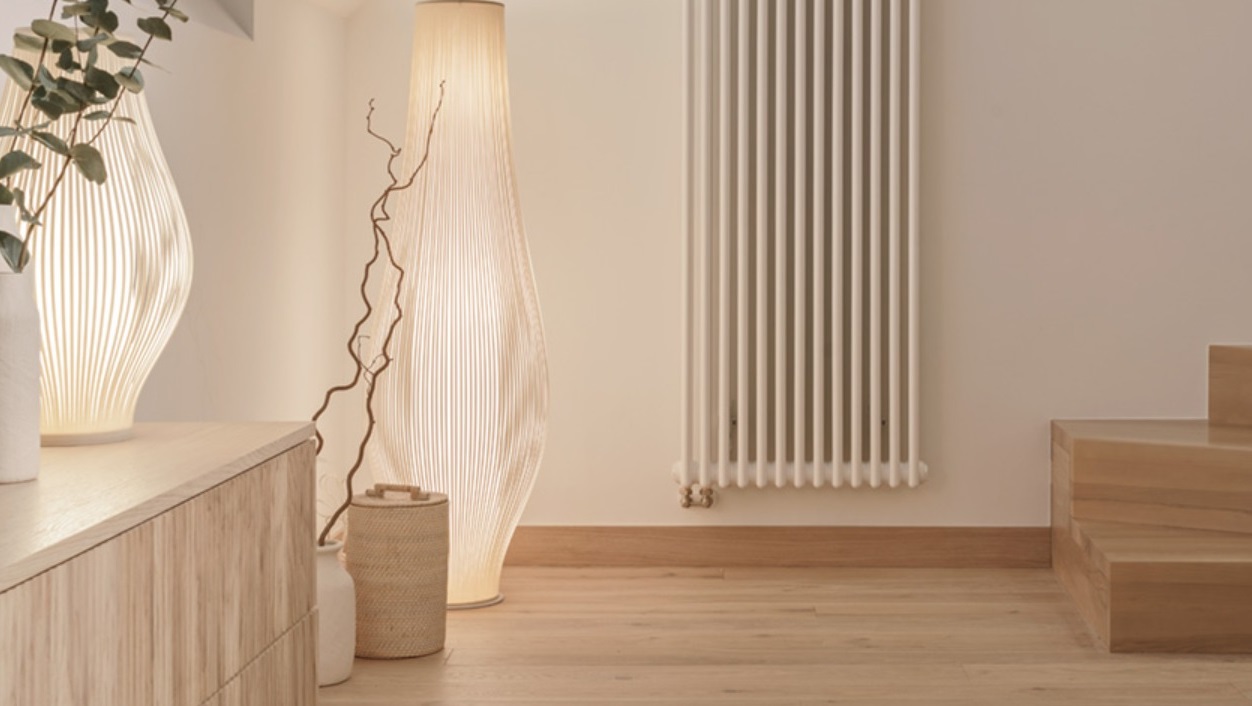
Wabi Sabi: Japanese Minimalism
The Wabi Sabi lifestyle emphasizes simple living, clarity, and simplicity. In this sense, it’s akin to minimalism but differs in several principles.
Embracing Imperfect Beauty
Wabi Sabi celebrates imperfection. An old cracked vase is a must-have in this aesthetic. Ultimately, design flaws tell a story and give the room personality. Feature walls made of concrete, natural stone, or untreated wood are also acceptable.
Appreciation for Nature
Natural materials are often imperfect and are therefore integral to Wabi Sabi. Furniture and accessories made of wood, leather, handcrafted stoneware, or glass contribute to a cozy ambiance. Natural decorations such as dried flowers, twigs, or grass in large, imperfect vases are striking in their simplicity.
Playing with Light and Shadow
While minimalism favors well-lit spaces, Wabi Sabi also values the interplay of light and shadow. Semi-transparent embroidered curtains create an intriguing contrast of light and dark. Opt for large windows if feasible. Light fabrics and natural textiles in shades like white, cream, or beige have a soothing effect and make the clean style inviting.
Living a minimalist lifestyle: It makes sense to let go.
The increasing popularity of Marie Kondo, an expert in tidying and organizing, speaks volumes: releasing unnecessary things is beneficial. Embracing minimalism is gaining more and more followers, and numerous studies confirm the positive impact of a simple, uncluttered environment.
Embracing minimalism allows you to express your contemporary philosophy of renunciation in an attractive manner. By choosing the right furniture and accessories, you can blend comfort with appealing decor, resulting in an enhanced lifestyle.
Minimalist living room
More living space
A minimalist living room is timeless, elegant, and centered around the essentials; it provides a peaceful environment for the mind. The key rule for this style is “less is more,” but it doesn’t mean the room has to feel stark and plain. Explore a variety of minimalist interior design ideas to find maximum inspiration.
The appropriate furniture for a minimalist living room
A modest sofa, a tidy table, and a few simple shelves are essential. Few carefully selected and strategically placed accessories add the finishing touch. The most important element in a minimalist living room is the sense of spaciousness. This private sanctuary is about you—not your possessions. It’s a space for contemplation, relaxation, and living. Therefore, it’s crucial to choose your furniture pieces thoughtfully.
Tall shelves and closed cabinets
The principle of “less is more” applies here. Light neutral colors and only two or three color accents create a soothing visual experience. Sleek, unadorned shelves in gray or cream add verticality to the room.
By keeping the doors closed, cabinets appear tidier than open shelves. If they are used as shelves, arranging books by size and color brings visual serenity to the room.
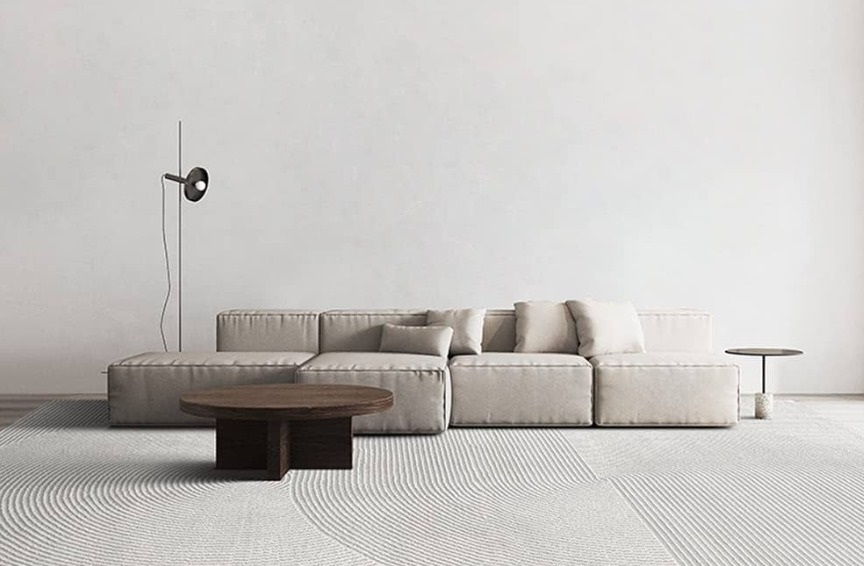
White minimalism
Minimalism is about understanding what you truly need, including the size of your furniture. Luxurious armchairs are out of place. Instead, opt for transparent or white acrylic chairs, light sofas, and white lacquered tables and sideboards for a light, simple, and unobtrusive look. Pairing these with light flooring creates a clear, almost ethereal ambiance. In a room like this, you naturally breathe a sigh of relief, and a sense of inner peace emerges on its own.
Maintaining a tidy living room requires some discipline, but smart storage solutions are vital. Cables can be concealed in the sideboard, while miscellaneous items can be hidden in attractive baskets, resulting in a harmonious overall aesthetic.
It’s all about the combination
White evokes clarity, purity, and freshness, but to some, it may also seem sterile and cold. Add warmth and rustic charm to the room with a darker wooden dining table, perhaps with a distressed finish. This soft contrast makes the minimalist setting cozier. For a modern touch, introduce furniture with chrome or glass elements, such as a sleek metal table with a glass top, perfect for setting down your coffee cup.
Multifunctional furniture with multiple uses
Minimalism in the living room is made simpler with multifunctional pieces like a sofa bed, a dining table, or an extendable bench—each providing space and practicality. Keeping surfaces free creates an open and orderly appearance in your living room.
Simplicity: Appropriate decorations for a minimalist living room
Whether it’s a minimalist children’s room or a living room, the cardinal rule for this style is “less is more.” This principle also applies to home accessories. They serve no purpose and distract from what’s important. With the following tips, your living room can maintain a decorative and distinctive ambiance.
- A glass table with a captivating picture book, a simple vase with wildflowers, and an unassuming fruit bowl—these are all the decorations you need in your minimalist living room. Vibrant oranges, apples, or bananas add a touch of natural color and provide essential vitamins on your table. Artfully arranged groupings create a focal point and structure in the space. Odd numbers of objects work well together, such as three white or gray decorative elements arranged as an ensemble, achieving a simple and elegant look.
- No clutter here? Exactly! All accessories and small items are stored in plain white chests of drawers and attractive light wooden chests. Only a few personal mementos adorn the sideboard or shelves, such as pretty shells, family photos, or handmade crafts. They don’t have to be trendy or stylish—anything that brings a smile to your face is worth keeping.
- Tidiness doesn’t have to mean discomfort. In a minimalist living room, a few earth-toned pillows and blankets in shades like “Avocado” or “Mexican Sand” provide comfort. Warm colors and soft fabrics lighten the overall impression. If that’s still too consistent for you, consider embracing the Wabi Sabi interior design style, which deliberately celebrates imperfections.
- Minimalism in the living room means no carpets or mats, only large, smooth surfaces. Modern, bright furnishings create an interesting contrast with dark parquet or laminate floors. A small, cozy rug made of natural materials in front of the sofa is essential for adding warmth and sensory delight. Consider a light Berber carpet for a touch of wanderlust that fits perfectly into a modern, minimalist atmosphere.
- Even if the walls are mostly bare, there’s still room for creativity. A simple white frame holding a single large-format picture can create a harmonious accent. For the ultimate minimalism, try framing white paper. Embrace open spaces to create a calm and light-filled environment.
- Windows play a part in the minimalist trend as well. Floor-length curtains in natural colors like gray or white allow for a beautiful view, making the room appear taller and welcoming in natural light. Opaque curtains provide privacy while still allowing natural light.
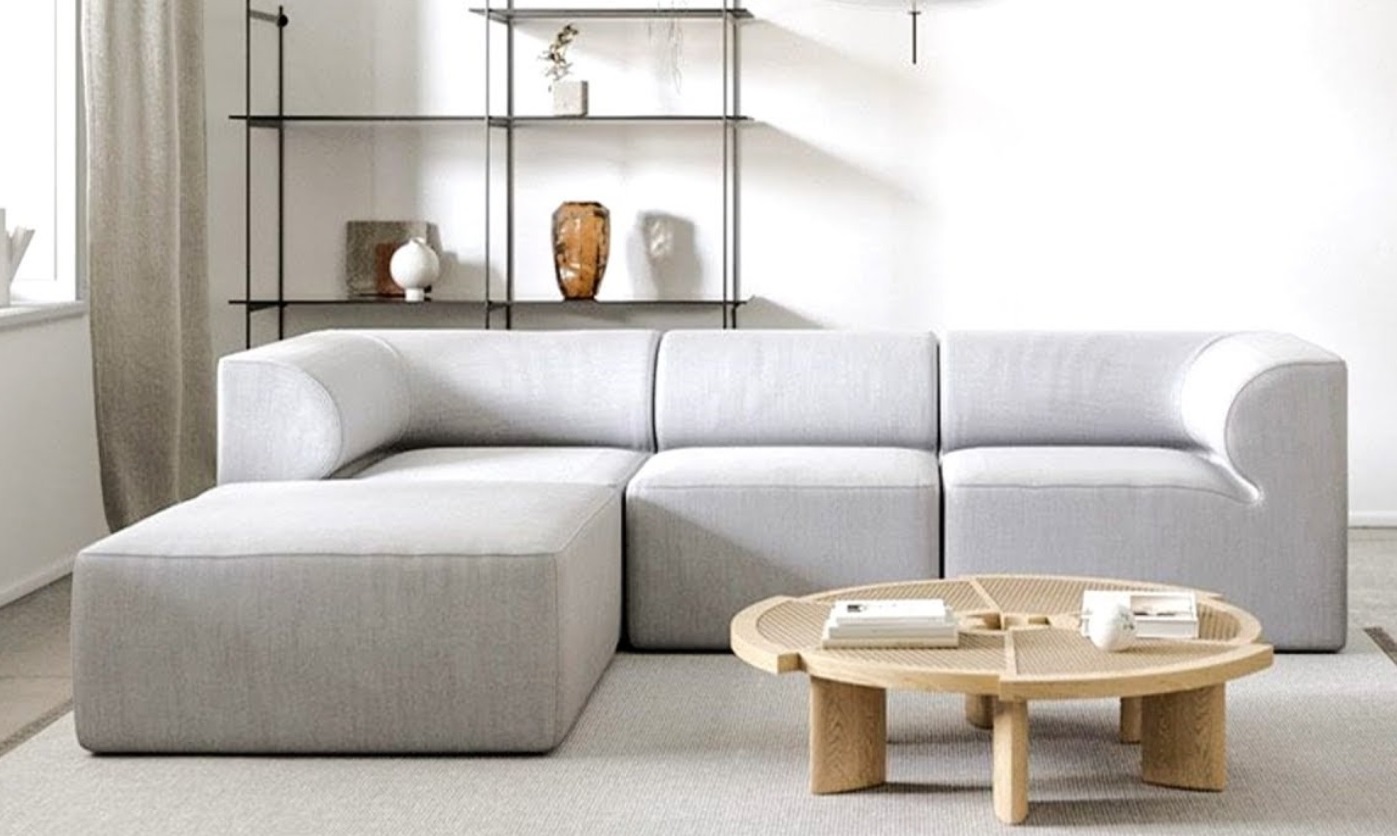
Here’s how to illuminate your minimalist living room
Lighting is abundant in a minimalist living room—natural light during the day and soft artificial light at night. Concealed lamps provide brightness without being obtrusive, while simple bases and wall strips discreetly house the light source.
Your trusty minimalist floor lamps
A minimalist floor lamp with a sleek design made of brass that emits light upwards is a classic choice. Indirect lighting enhances the spaciousness of your living room, and floor lamps work well alongside armchairs.
Create a reading nook with the “bend trick”
A table lamp in the living room? Absolutely! A subtle white lamp with a bent arm looks elegant on a side table, harmonizing with the light wall color and creating a cozy reading corner. Stylish chrome arc lamps also serve this purpose.
Shine a light on your favorite artwork
Apart from modern-looking ceiling and wall lights, consider LED strips or light coves to illuminate corners and emphasize empty spaces in your living room. A spotlight or a single pendant lamp made of stainless steel can draw more attention to your favorite painting.
Frequently asked questions
Minimalist living room decorating follows the principle of “Less is more.” Streamline your furniture and accessories to create a calm, minimalist look with clean lines and simple shapes. Opt for bright, multifunctional furniture to create additional space and make the living room feel more open.
Use shelves with closed cabinet fronts to keep belongings out of sight, fostering a neater and more harmonious living room atmosphere. Choose delicate, simple decorative items that further accentuate the minimalist style.
Remember to embrace the art of minimalism by reducing the number of stools, side tables, and plants to give your living room ample breathing space.
For a minimalist living room, focus on three specific decorative elements: thin floor-length curtains for natural light, a few cushions and blankets in soft colors for comfort, and a single large-format picture in a white frame for a harmonious accent.
Minimalist living room essentials
Despite its strictness, minimalism creates a relaxed atmosphere in the living room. Opt for essential or multifunctional furniture in light colors. Elements made of wood, glass, chrome, or stainless steel provide a smooth, structured surface or a subtle shine. Keep surfaces and walls tidy, adding a few decorative elements for warmth and nostalgia. Comfort is expressed through individual pillows and blankets in earth tones. When it comes to lighting, ensure every corner is illuminated for transparency and dimension, creating a calming serenity for you and your guests.
Adopt Wabi-Sabi style
Japanese aesthetics for your home
Wabi-Sabi offers a counterbalance to our fast-paced lives, encouraging us to focus on what’s truly important and embrace imperfections. Apply this Japanese philosophy to your apartment, fostering peace and harmony through less perfectionism.
Wabi Sabi, or the myster of Zen Buddhists
An elegant living space, a flawless dining table, a lavish bathroom – Pinterest, Instagram, and similar platforms are filled with influencers aspiring to achieve these standards. Wabi Sabi challenges the obsession with continuous perfection. Rooted in Asian Zen Buddhism, this Japanese approach seeks beauty in imperfection. Wabi translates to “solitude”, “desolation”, or “sadness”, while Sabi refers to “patina”, “aging”, or “transience”. The concept revolves around the idea that true beauty is revealed when things are unique, delicate, and ephemeral.
A prime illustration of this principle is Japanese pottery. A bowl, cup, or plate is considered exceptionally valuable if it exhibits visible cracks, distinctive patina, or is mended with gold lacquer at broken points.
Similar to minimalism and purism, Wabi Sabi is about focusing on the essentials. This does not imply living an austere life and completely forsaking beautiful objects. Instead, this lifestyle encourages cherishing and continuing to use items that have withstood the test of time. For instance, consider the plate passed down from your grandmother, the pillow you crafted yourself, or the chest you purchased at a flea market. These are cherished possessions that you wouldn’t readily trade for a new model, right? That is the essence of the Wabi-Sabi philosophy.
As evident, Wabi Sabi involves more than just incorporating Japanese furniture into your home. If you are unsure where and how to begin, start by decluttering. Dispose of items like the unused salad spinner in the kitchen cupboard, the dusty large vase tucked away in the far corner of your apartment, or the perpetually vacant newspaper rack in the living room. This creates space for your beloved items while fostering peace and harmony within your living space and daily life. Moreover, it benefits not just you, but also your children: a touch of wabi sabi and minimalism in the children’s room shield them from being constantly overwhelmed by stimuli.
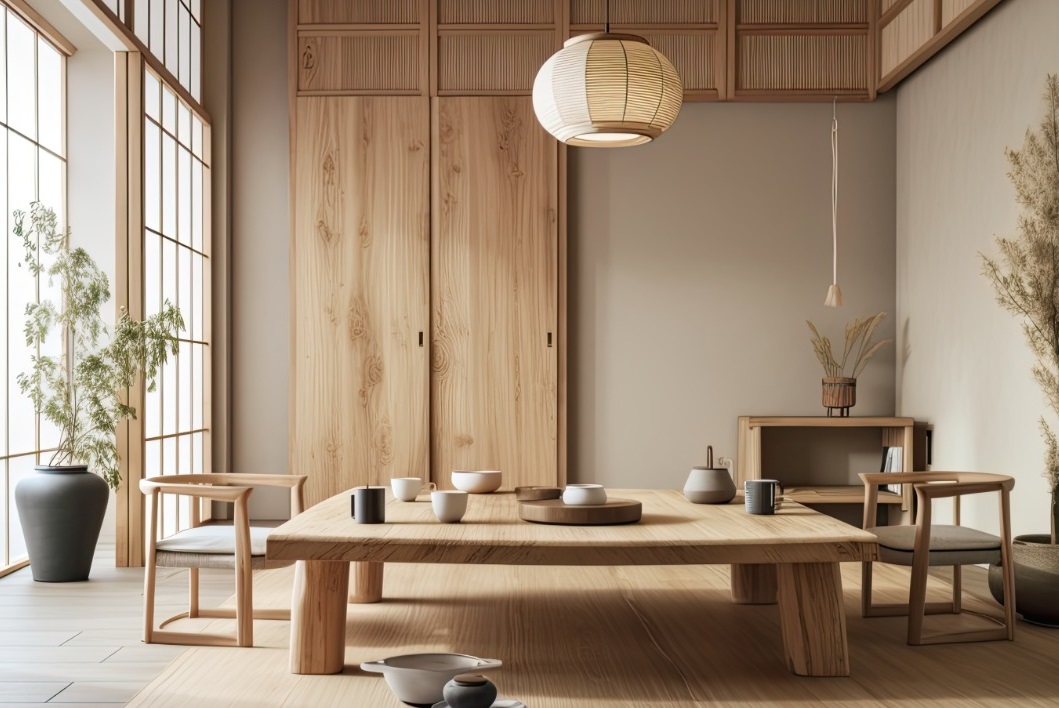
Your Wabi Sabi style apartment
Uncomplicated, modest, and uncluttered – this characterizes a minimalist living room. Visual openness forms the basis of a wabi-sabi style room as your existing possessions require space to radiate their complete beauty. Additionally, draw inspiration from the following principles:
Harmonious: natural-toned colors
Light gray or white are subtle and universally complement a minimalist interior. If these seem too dull, consider using soft beige in varying shades of sand or rose, pale blue, or muted earth tones for your Wabi Sabi-style walls. These hues exude peace, warmth, and security.
Authentic: Natural materials
Furniture and decor fashioned from natural materials harmonize perfectly with Wabi Sabi. Handcrafted pieces made from uniquely grained wood, with uneven surfaces or irregular patterns, possess distinctive and captivating imperfections. Ceramics, pottery, and linen introduce a sense of naturalness to your living space. Combining different materials creates particularly intriguing effects.
Asymmetric: Organic shapes
Wabi Sabi embraces all forms based on nature, be it dynamic curves or gentle undulations. Farewell to rigid angles and edges, symmetry, and precise arrangement.
Wabi-Sabi Furniture: Ready for a change of perspective?
Embracing Wabi Sabi entails adopting a new perspective and appraising things differently from the norm. Flaws are approved, while flawless design is not sought after. Thus, Japanese aesthetics share similarities with Shabby Chic or Industrial styles, relying on patina and simple design. Would it upset you if your child accidentally scratched your glass table while playing? Or if the neighbor’s dog gnawed on the wooden chair? Not if you have internalized the Wabi-Sabi philosophy already. Japanese aesthetics pay attention to the little things.
Anecdotes recount that Sen no Rikyu, the 16th-century Japanese monk, tea party host, and pioneer of the wabi-sabi philosophy, once tended a garden. He meticulously raked the ground until it appeared immaculate. Upon contemplation, he shook a cherry blossom tree, allowing a few blossoms to randomly fall to the ground. Only then was he satisfied. Whether true or fictional, this anecdote serves as inspiration to infuse Wabi Sabi into your own abode. Even a few petals can make a significant impact.
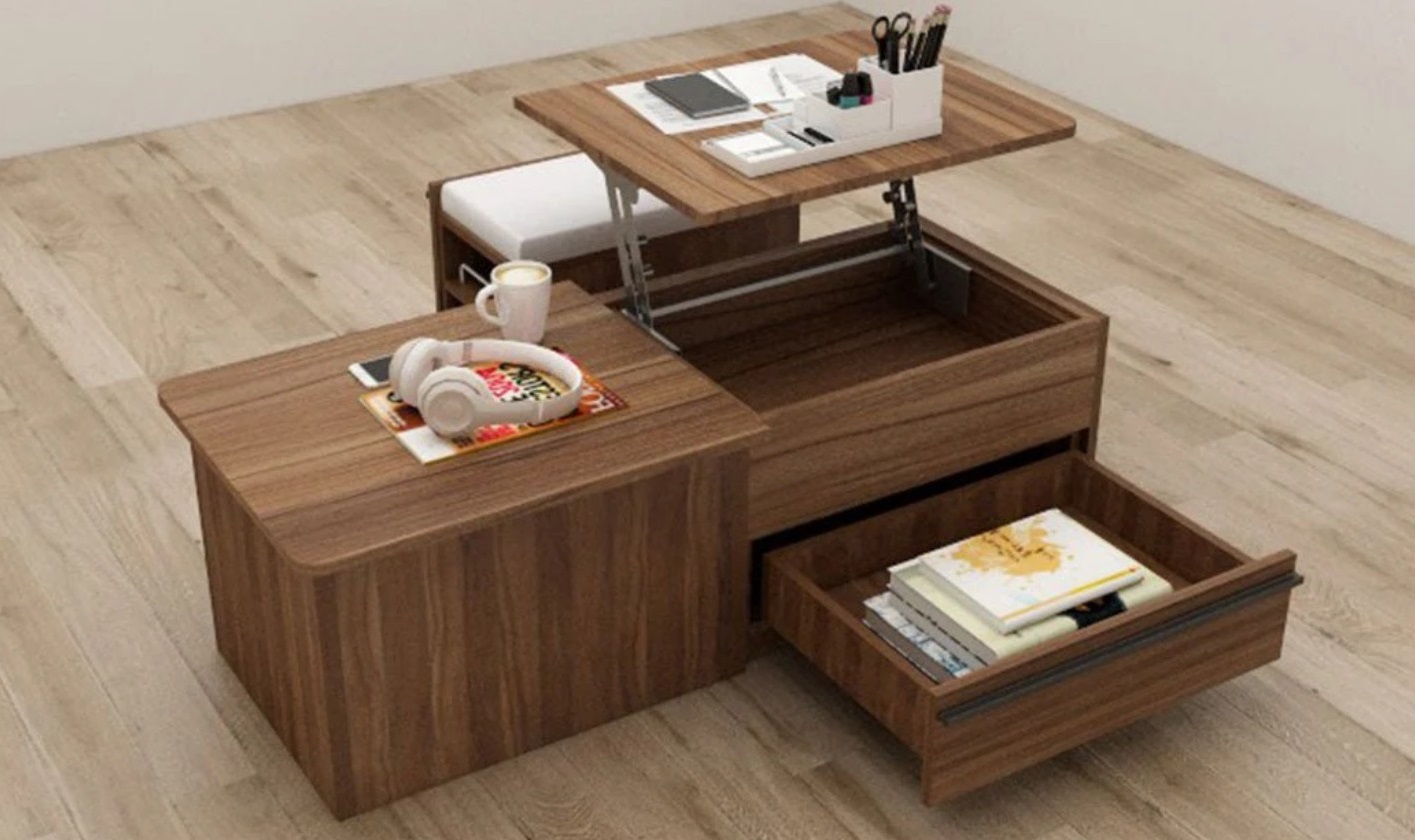
Multifunctional furniture
Discover the versatile nature of these all-purpose pieces
Convenient, functional, and chic: multifunctional furniture not only saves space but also offers additional storage options. Clever combinations swiftly create a secondary room where there was none previously. With our pointers and strategies, you can maximize the space in your living space.
Space-saving versatile furniture: Here’s a guide to optimizing space in your home
Versatile furniture provides a smart solution for interior enthusiasts. If you desire adaptable design for your space, furniture with dual purposes is ideal, especially for compact apartments like one-bedroom units or rooms serving as both a living and dining area. Unlike in the past, today’s multi-functional furniture boasts contemporary designs and intelligent features.
Multi-functional furniture for the living room
The living room is the focal point of every home where you can entertain guests, read a book, or enjoy a cozy evening watching TV. In small apartments, the living room often doubles as a dining area. If you don’t have a guest room or live in a studio apartment, the bedroom spills into the living room. Multi-functional furniture becomes invaluable when space is limited but creativity is high.
Convertible sofas and wall beds
The convertible sofa is a classic multi-functional piece. During the day, it serves as seating for guests, and at night, it transforms into a comfortable bed. The next morning, simply stow away the bedding in the dedicated drawers. As an alternative to the convertible sofa, the Murphy bed swiftly unfolds into a bed.
One piece, two purposes: furniture for small spaces
Maximize small areas by opting for furniture with multiple uses.
For instance, a coffee table with built-in shelves is recommended for a small living room. It provides quick and tidy storage for books and magazines. Additionally, it functions as a dining table or work desk. It is paramount to ensure ample room to accommodate hungry guests.
No space for a coffee table? Consider an armchair with an attached table. Enjoy comfortable seating with snacks within reach, ensuring a delightful movie night.
Conceal and reveal: the pull-out table
Experts advise delineating living and work areas to allow for a work-break balance. This is often challenging in small apartments lacking a dedicated study space. However, versatile furniture helps create a relaxing atmosphere after a busy day. The solution lies in an expandable table. The tabletop can be extended and concealed for work purposes, leaving a modern table with space for personal items.
A modern console table as a dining area
Sleek and fitting for small spaces, modern console tables save space and effortlessly double as dining tables in minimalist settings. Most console tables feature integrated drawers or shelves, providing additional storage.
Visible at all times: multi-functional mirror in the bedroom
Combining storage and a mirror
In bedrooms with limited wall space due to wardrobes and shelves, a multi-functional mirror becomes indispensable.
A popular option is a mirror integrated into the wardrobe. The wardrobe doors replace a full-length mirror, providing storage for clothing items. Another practical choice is a mirror with an integrated ironing board and clothes rack.
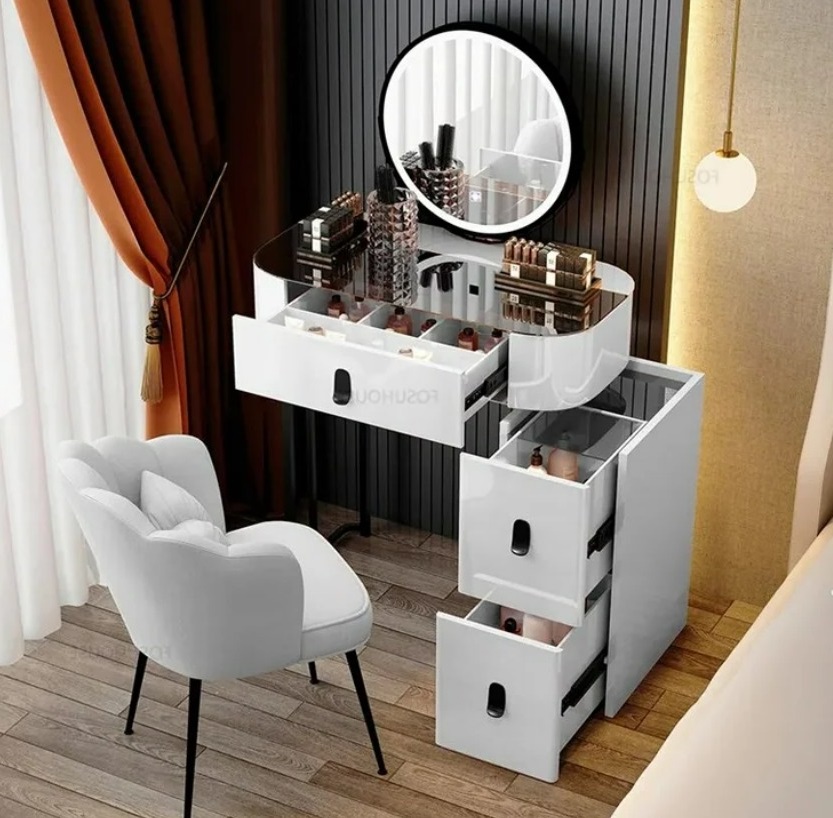
Practicality meets style: table and mirror combo
Another suggestion is a combination of a chest of drawers and a table with an attached mirror. Store your favorite accessories in the drawer and make use of the hinged mirror. Set essential items such as nail polish, powder, and eye shadow on the shelves and in the drawers, thereby keeping the bedroom tidy.
Maximize kitchen space with versatile furniture
Your kitchen may be narrow with limited space for a small table, but you can still realize your dream of cooking with friends in the evening using multi-functional furniture.
For those who love to cook and entertain, an expandable dining table is ideal for a small kitchen or narrow living room. This saves space on a daily basis and prevents collisions with large furniture. When guests arrive, simply expand the table to accommodate everyone comfortably.
If your kitchen lacks storage, consider modular shelves with built-in countertops. Arranging three shelves side by side creates a lovely dining table with ample space for your favorite dishes and cookbooks.
If you only need a chair for breakfast but want to host dinner guests, consider getting a folding chair. It can be conveniently stored and quickly set up when needed.
Frequently asked questions
What is meant by multifunctional furniture exactly?
Multifunctional furniture is highly versatile and ideal for small spaces or nooks with limited room. Intelligent furniture combines multiple functions into one. For instance, a sofa bed not only provides a comfortable spot to relax while watching TV with the family, but it can also be easily transformed into a sleeping space for guests.
This category also includes extendable dining tables, which offer ample space for family meals and can be quickly extended for guests. Additionally, standing shelves offer practical storage and can double as a room divider, visually separating the living room from the dining area for a more organized layout.
What are the benefits of multifunctional furniture?
Opting for multifunctional furniture not only saves space, but it also saves money. With its diverse functions, there’s no need for separate purchases such as individual beds and sofas for the living room.
Multifunctional furniture also allows for hidden storage spaces. For example, a mirrored cabinet in the bathroom not only provides room for cosmetics, hygiene products, and a hair dryer, but also offers valuable assistance during morning routines such as teeth brushing and applying makeup.
